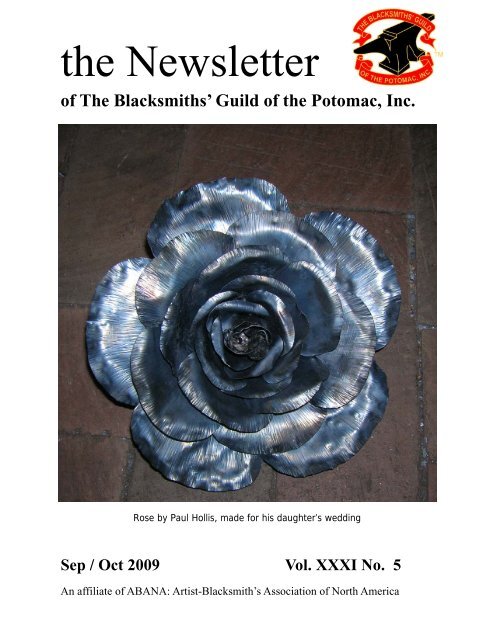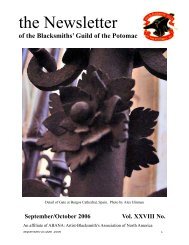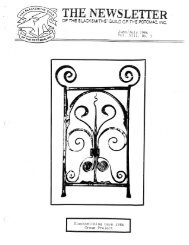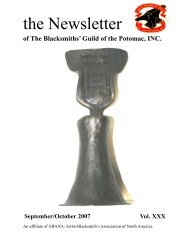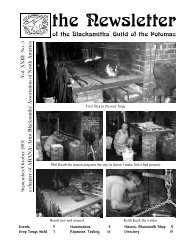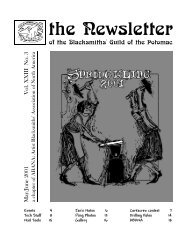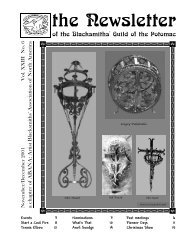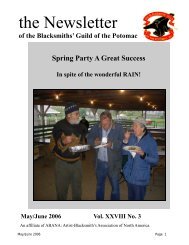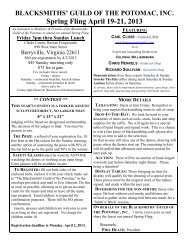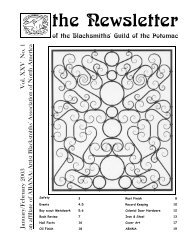September/October - Blacksmiths' Guild of the Potomac
September/October - Blacksmiths' Guild of the Potomac
September/October - Blacksmiths' Guild of the Potomac
You also want an ePaper? Increase the reach of your titles
YUMPU automatically turns print PDFs into web optimized ePapers that Google loves.
<strong>the</strong> Newsletter<br />
<strong>of</strong> The Blacksmiths’ <strong>Guild</strong> <strong>of</strong> <strong>the</strong> <strong>Potomac</strong>, Inc.<br />
Rose by Paul Hollis, made for his daughter’s wedding<br />
Sep / Oct 2009 Vol. XXXI No. 5<br />
An affiliate <strong>of</strong> ABANA: Artist-Blacksmith’s Association <strong>of</strong> North America
The <strong>Blacksmiths'</strong> <strong>Guild</strong> <strong>of</strong> <strong>the</strong> <strong>Potomac</strong>, Inc.<br />
2009 Officers & Board <strong>of</strong> Directors<br />
President<br />
Board Members<br />
*George Anderton (2009)<br />
Keith Kuck (2010) 5310<br />
989 S. Sleepy Creek Rd.<br />
Nutting Dr. Springfield,<br />
Cross Junction VA 22625<br />
Va. 22151 703-321-8109<br />
540-888-3908<br />
gtadma@hughes.net Pat McGuire (2011)<br />
Vice President (and 1102 Shannon Pl<br />
Shop Master)<br />
Herndon VA 20170-3506<br />
*Phil Heath (2011) 703-437-9034<br />
4600s four Mile Run Dr Jeff Symanski (2010)<br />
Arlington VA 22204 6183 Carters Run Rd<br />
703-671-3134<br />
Marshall VA 20115-2027<br />
Treasurer<br />
540-341-3031<br />
*Fred (Hop) Long (2009)<br />
5309 Bangor Drive<br />
Kensington MD 20895-1106<br />
301-942-6177<br />
Secretary<br />
*Mike Briskin (2011)<br />
1556 N Bryan St<br />
Arlington VA 22201<br />
703-524-2362<br />
* Member <strong>of</strong> <strong>the</strong><br />
Executive Committee<br />
David Murphy (2009)<br />
7910 Woodrow Pl<br />
Cabin John MD 20818-<br />
1638 301-229-5794<br />
Bill Wojcik (2010)<br />
4116 Kingchase Lane<br />
The Plains VA 20198<br />
540-253-5121<br />
The Newsletter is mailed to members six times a<br />
year, Initial membership is $35 or three years for<br />
$75. Renewals are $25 for one year or $70 for<br />
three years. Membership applications and renewals<br />
may be sent to Katie Dunn, 531 Merlins Lane, Herndon,<br />
VA 20170. Check payable to BGOP.<br />
ABANA affiliates may reprint portions that are not<br />
individually copyrighted, so long as credit is given to<br />
original source. Any o<strong>the</strong>r publication by prior<br />
arrangement with president <strong>of</strong> BGOP. The<br />
Blacksmiths’ <strong>Guild</strong> <strong>of</strong> <strong>the</strong> <strong>Potomac</strong>, Inc, its <strong>of</strong>ficers,<br />
members, and editorial staff specifically disclaim<br />
any responsibility for damages or injuries that<br />
occur as a result <strong>of</strong> <strong>the</strong> use in any way <strong>of</strong> any<br />
information contained in this newsletter. Send articles<br />
to bgopnewsletter@gmail.com.<br />
Shop Rules And Etiquette<br />
The <strong>Guild</strong> shop is available for use by members in good<br />
standing whenever <strong>the</strong> Nature Center park is open. The<br />
shop is locked, so call <strong>the</strong> shopmaster or a board member<br />
for access. Follow all safety rules. Record <strong>the</strong> number <strong>of</strong><br />
visitors on <strong>the</strong> log sheet near door.<br />
Please observe <strong>the</strong> following rules and etiquette:<br />
♦ Two people must be present in <strong>the</strong> forge to work.<br />
♦ Bring safety glasses and wear <strong>the</strong>m. Work in a safe<br />
manner at all times.<br />
♦ Clean <strong>the</strong> shop before and after you work.<br />
♦<br />
♦<br />
♦<br />
♦<br />
♦<br />
♦<br />
♦<br />
♦<br />
♦<br />
Committees & Assignments<br />
10 Yr Plan ….…...Dave Murphy, Chair...…...301-229-5794<br />
Corporation………..Fay LeCompte, Chair…...…..540-743-1812<br />
Scholarships……...Fay LeCompte, Chair…..….540-743-1812<br />
Demonstrations…Jan Kochansky………...………....301-432-7734<br />
Meeting Raffle….Dave Murphy ....………………….301-229-5794<br />
Hotline………………...Charlie Perticari…………...………….....301-982-9430<br />
Library………………...Steve Crist………..………….…...703-754-9678<br />
Web Master ……….Dick Smith ..…………….…….301-807-0342<br />
Membership and<br />
Newsletter Editor.. Katie Dunn………………..…................703-435-4254<br />
email at BGOPnewsletter@gmail.com<br />
Empty firepots and dump ash gate after each use to<br />
minimize corrosion.<br />
Dump cold ashes in <strong>the</strong> ash dump outside, at <strong>the</strong> side<br />
<strong>of</strong> <strong>the</strong> shop.<br />
Place tools back in <strong>the</strong>ir proper places.<br />
Dress bar ends which you have cut, to be ready for<br />
<strong>the</strong> next user.<br />
Clean <strong>the</strong> shop before you leave, and carry out trash<br />
which you create.<br />
Always turn out <strong>the</strong> lights and lock up when leaving.<br />
Bring your own material for personal projects. Shop<br />
stock is for learning and practice.<br />
No alcoholic beverages on park property.<br />
No propane can be stored on <strong>the</strong> property.<br />
Scholarship Applications<br />
Scholarship applications are available on <strong>the</strong> web at<br />
www.bgop.org. Completed forms should be sent to:<br />
Fay LeCompte III, 1016A East Main Street, Luray, Va.<br />
©2008 Blacksmiths’ <strong>Guild</strong> <strong>of</strong> <strong>the</strong> <strong>Potomac</strong>, Inc., and as copyrighted by individual contributors.<br />
<strong>September</strong>/ <strong>October</strong> 2009 The Blacksmiths’ <strong>Guild</strong> <strong>of</strong> <strong>the</strong> <strong>Potomac</strong>, Inc. 2
CONTENTS<br />
5- Modern Blacksmithing excerpt<br />
6 - Web Links/ Upcoming Events<br />
8— Making Scissors<br />
12- JunkYard Steels<br />
13— Library listing<br />
18— Show and Tell<br />
19- For Your Inspiration<br />
Oct 2<br />
Oct 16<br />
Oct 30<br />
Nov 6<br />
Nov 20<br />
Dec 4<br />
Dec 5<br />
Dec 18<br />
Meeting Schedule<br />
Rivet Decorating Tools<br />
Decorating Rivet Heads<br />
Board Meeting<br />
Quick Demo Items<br />
Cow Bells<br />
Open Forge<br />
Annual Dinner<br />
Open Forge<br />
Touchstone Center for Crafts, southwestern<br />
PA www.touchstonecrafts.com<br />
CLASSES<br />
Haystack Mountain School <strong>of</strong> Crafts, Maine<br />
www.haystack-mtn.org<br />
Penland School <strong>of</strong> Crafts , northwestern<br />
NC www.penland.org<br />
John C. Campbell Folk School, southwestern<br />
NC www.folkschool.com<br />
Peters Valley , northwestern NJ<br />
www.pvcrafts.org<br />
Arrowmont School <strong>of</strong> Arts & Crafts,<br />
eastern Tennessee www.arrowmont.org<br />
New England School <strong>of</strong> Metalwork, Maine<br />
www.newenglandschool<strong>of</strong>metalwork.com<br />
Bill Pieh Resource for Metalwork, Arizona<br />
http://www.horseshoes.com/supplies/<br />
alphabet/piehtoolco/linksandresources/<br />
workshops/billpiehworkshop.htm<br />
Yesteryear Forge, Amelia VA 23002 yesteryearschool@gmail.com<br />
or 434-390-6203<br />
http://www.yesteryearschool.com<br />
Presidents message<br />
TIPS FROM OUR FORGE MASTER<br />
If an odd detail seems out <strong>of</strong> place in your design,<br />
think again<br />
(This message is in response to “Chapter 5: The Age <strong>of</strong> Iron Tutankhamen’s<br />
Tomb for <strong>the</strong> entire article see ………http://mygeologypage.ucdavis.edu/cowen/<br />
~GEL115/115CH5.html )<br />
OK why is it that historians and archeologists never have to prove what <strong>the</strong>y say is<br />
true? Instead many develop wild ideas that don't make sense when it comes to practical<br />
application. I have read this through and I think this article has some very interesting information<br />
in it. And I think it is very factual in nature. However, I am going to have to<br />
put my two cents in here because I have seen a problem here over and over again. The<br />
article is in my opinion not correct on one aspect <strong>of</strong> steel production. I do not believe<br />
that you can get steel by forging wrought iron. No matter how much you forge it<br />
<strong>September</strong>/ <strong>October</strong> 2009 The Blacksmiths’ <strong>Guild</strong> <strong>of</strong> <strong>the</strong> <strong>Potomac</strong>, Inc. 3
wrought iron is not going to gain enough carbon to make it steel. It might work except<br />
for one small problem. Scale. It is obvious <strong>the</strong> author has never taken hammer to metal<br />
in his life. When you forge wrought iron it scales a lot. More than steel. Try it and you<br />
will see. Any absorption <strong>of</strong> carbon into <strong>the</strong> top layer <strong>of</strong> <strong>the</strong> wrought iron will be immediately<br />
lost in <strong>the</strong> scale that forms.<br />
You can force carbon into wrought iron if you want but it has to be done in an oxygen<br />
free environment. This is how blister steel was made for centuries. Wrought iron<br />
plates were put into a sealed box with intermittent layers <strong>of</strong> carbonaceous material and<br />
heated to high temps for long periods <strong>of</strong> time. Several days I think I read somewhere<br />
were needed to complete <strong>the</strong> process. The resulting material was called "blister<br />
Steel". This was because <strong>the</strong> carbon migration was not uniform but formed bumps on <strong>the</strong><br />
surface <strong>of</strong> <strong>the</strong> iron. It is in effect a heavy form <strong>of</strong> case hardening. The resulting material<br />
still had to be reheated and welded into bars. And here is what <strong>the</strong> real story is all about.<br />
By reheating and forge welding <strong>the</strong> plates into bars <strong>the</strong> thick layer <strong>of</strong> carbon in <strong>the</strong><br />
plates was allowed to disperse to some extent through out <strong>the</strong> resulting bar. The more<br />
you folded and welded <strong>the</strong> bar <strong>the</strong> more uniform <strong>the</strong> carbon content. This in itself was<br />
not enough to make <strong>the</strong> carbon content uniform. It wasn't until some guy figured out<br />
how to take blister steel and melt it and <strong>the</strong>n cast it into molds that truly uniform carbon<br />
content tool steel was available. (The first big use for cast steel was in <strong>the</strong> production <strong>of</strong><br />
clock springs which had until that time been made from blister<br />
steel. These blister spring clocks were not reliable because <strong>of</strong> hard spots in <strong>the</strong> coil<br />
springs that would cause <strong>the</strong>m to break with normal use. The new cast steel springs didn't<br />
break which allowed <strong>the</strong> production <strong>of</strong> wind up clocks that could keep time aboard ship<br />
which greatly improved navigation.<br />
It made <strong>the</strong> clock maker a lot <strong>of</strong> money.)<br />
So you might ask what about those Japanese sword makers. Don't <strong>the</strong>y get carbon<br />
to migrate into <strong>the</strong>ir steel? No <strong>the</strong>y don't. What <strong>the</strong>y do is add pieces <strong>of</strong> wrought iron,<br />
steel and cast iron in small pieces all in a pile which <strong>the</strong>y forge weld into a lump. That<br />
lump is folded and welded several<br />
times, up to 16 times, to make a very large number <strong>of</strong> layers in that lump. I think that by<br />
doing all this folding and welding <strong>the</strong> layers <strong>of</strong> high carbon are so thin that <strong>the</strong> carbon will<br />
migrate from <strong>the</strong> high carbon layers to <strong>the</strong> lower carbon layers evening out <strong>the</strong> carbon<br />
content between layers. The<br />
carbon does not come into <strong>the</strong> steel from <strong>the</strong> charcoal fire. If any thing excess carbon<br />
goes <strong>the</strong> o<strong>the</strong>r way. They figured out how to take a pile <strong>of</strong> junk and make something<br />
useful out <strong>of</strong> it. If you look at <strong>the</strong> history <strong>of</strong> our craft I think you will see that that is what<br />
has been going on <strong>the</strong> whole<br />
time. But carbon into iron from <strong>the</strong> fire, no way.<br />
If I am wrong please show me. I want to know.<br />
George Anderton<br />
<strong>September</strong>/ <strong>October</strong> 2009 The Blacksmiths’ <strong>Guild</strong> <strong>of</strong> <strong>the</strong> <strong>Potomac</strong>, Inc. 4
One response to <strong>the</strong> previous message<br />
By Jan Kochansky<br />
It wasn't until <strong>the</strong> puddling process was worked out that wrought iron became a reliably<br />
low-carbon product. In a bloomery, depending on <strong>the</strong> ore/charcoal ratio, carbon content<br />
could vary, sometimes within <strong>the</strong> same bloom. You get s<strong>of</strong>t bits and steely bits. There<br />
was a workshop a couple <strong>of</strong> years ago at Baltimore Knife and Sword, where <strong>the</strong> demonstrator<br />
made fairly decent steel in a bloomery, and at <strong>the</strong> BGCM days last May, <strong>the</strong> bloom<br />
was <strong>of</strong> varying carbon content on <strong>the</strong> basis <strong>of</strong> forging characteristics and, reportedly,<br />
spark tests. The same thing happens in <strong>the</strong> Japanese bloomery; <strong>the</strong> product bloom is broken<br />
up, and pieces <strong>of</strong> different carbon content are selected on <strong>the</strong> basis <strong>of</strong> fracture characteristics<br />
to be used in different parts <strong>of</strong> <strong>the</strong> sword.<br />
You don't necessarily need to add carbon to wrought iron in order to get steel.<br />
From MODERN BLACKSMITHING 1904<br />
by J. G. HOLMSTROM<br />
ONE <strong>of</strong> <strong>the</strong> chief reasons why <strong>the</strong> blacksmith is not so successful nor respected as<br />
before is his intemperance. The danger for <strong>the</strong> smith becoming a drunkard is greater<br />
than for any o<strong>the</strong>r mechanic. It is <strong>of</strong>ten <strong>the</strong> case that when a customer pays a bill<br />
<strong>the</strong> smith is requested to treat. This is a bad habit and quite a tax on <strong>the</strong> smith.<br />
Just think <strong>of</strong> it—fifteen cents a day spent for liquor, will, in twenty-five years, amount<br />
to $9,000. Then add to this fifteen cents a day for cigars, which will, in twenty-five<br />
years, amount to $9,000 at ten per cent compound interest. If <strong>the</strong>se two items<br />
would be saved, it will give a man a farm worth $18,000 in twenty-five years. How<br />
many smiths are <strong>the</strong>re who ever think <strong>of</strong> this? I would advise every one to put aside<br />
just as much as he spends for liquor and tobacco; that is, when you buy cigars or<br />
tobacco for twenty-five cents put aside as much. When you buy liquor for one dollar<br />
put aside one dollar. Try this for one year and it will stimulate to continual effort in<br />
that direction. The best thing to do is to "swear <strong>of</strong>f" at once, and if you must have it,<br />
take it out <strong>of</strong> business hours. Politely inform your friends that you must stop, or it<br />
will ruin you. If you drink with one you must drink with ano<strong>the</strong>r, and <strong>the</strong> opportunity<br />
comes too <strong>of</strong>ten. When you have finished some difficult work you are to be treated;<br />
when you trust you are to be treated; when you accommodate one before ano<strong>the</strong>r<br />
you are to be treated; when you order <strong>the</strong> stock from <strong>the</strong> traveling man you are to<br />
be. treated. Some smiths keep a bottle in a corner to draw customers by; o<strong>the</strong>rs tap<br />
a keg <strong>of</strong> beer every Saturday for <strong>the</strong> same purpose. No smith will ever gain anything<br />
by this bad practice. He will only get undesirable customers, and strictly temperance<br />
people will shun him for it. What he gains on one side he will lose on ano<strong>the</strong>r. Besides<br />
this he will in <strong>the</strong> long run ruin himself physically and financially. Let <strong>the</strong> old<br />
smith quit and <strong>the</strong> apprentice never begin this dangerous habit. A smith that is drunk<br />
or half drunk cannot do his duty to his customers, and <strong>the</strong>y know it, and prefer to<br />
patronize a sober smith.<br />
<strong>September</strong>/ <strong>October</strong> 2009 The Blacksmiths’ <strong>Guild</strong> <strong>of</strong> <strong>the</strong> <strong>Potomac</strong>, Inc. 5
WEB LINKS<br />
• http;//www.bgop.org<br />
• http://www.grizzly.com/<br />
• workshopplanner.aspx<br />
• http;//www.Backyardmetalcasting.com<br />
• http://www.1728.com (math & geometry)<br />
• http://memory.loc.gov (images at Library<br />
<strong>of</strong> Congress)<br />
• http://wwwironkisshammers.com<br />
• http://home.earthlink.net/~bazillion/<br />
intro.html<br />
• http://<br />
www.macefamilyblacksmithing.com<br />
• http://www.watchman.dsl.pipex.com/<br />
filemaking/index.html<br />
• http://www.random.org/sequences/<br />
• http://en.wikipedia.org/wiki/<br />
blacksmith<br />
• http://blog.wired.com/<br />
underwire/2008/08/math-strangedr.html<br />
• http://www.metalsmith.org/pub/<br />
mtismith/VO5.3/Hist-anvil.htm<br />
• http://www.blksmth.com/How_%<br />
20to_%20Index.htm NEW<br />
• http://gilderspaste.com NEW<br />
UPCOMING EVENTS<br />
Oct 10 from 1-5pm Pioneer Day-Gulf<br />
Branch Nature Center 1-5pm arrive early to<br />
set up for demo– note that parking lot is<br />
closed. No rain date call 703-228-3403 after<br />
8 am for a recorded message about cancellation.<br />
Oct 10, 10-4:30 Festival <strong>of</strong> <strong>the</strong> Building Arts<br />
National Building Museum in celebration <strong>of</strong><br />
our built environment. Interactive fun for<br />
all ages.<br />
http://www.nbm.org/families-kids/festivals/<br />
foba.html<br />
Oct 10-11 Page County Heritage Festival in<br />
Luray VA. Local crafters, food, steam and<br />
gas small engine show http://<br />
luraypage.com/heritage/<br />
Oct 10, 10-3 Cherry Hill Farm Day, Falls<br />
Church VA. Set up 9am under <strong>the</strong> ro<strong>of</strong>ed<br />
pavilion.<br />
Oct 17 9-5pm Aldie Harvest Festival, an<br />
annual celebration featuring food, entertainment,<br />
vendors, crafts, bake sales, grinding<br />
and blacksmithing. Aldie is located on route<br />
50 one mile west <strong>of</strong> route 15.<br />
www.village<strong>of</strong>aldie.com/harvestfest.htm<br />
Nov 7-8 from 10-4 Blacksmith and Friends<br />
Christmas show. At <strong>the</strong> Agricultural Farm<br />
Park in 18400 Muncaster Rd, Derwood MD.<br />
Admission is Free Call 301-807-0342<br />
Dec 5 BGOP Annual Holiday Party 5:30<br />
setup 6PM dinner. Church <strong>of</strong> <strong>the</strong> Covenant<br />
2666 Military Road Arlington VA<br />
Oct 10-11 Sou<strong>the</strong>rn Maryland Farm Life<br />
Festival, at <strong>the</strong> John K. Parlett Farm-Life<br />
Museum <strong>of</strong> Sou<strong>the</strong>rn Maryland. Near New<br />
Market, MD This is <strong>the</strong> last time this festival<br />
will be held<br />
www.farmlifefestival.com<br />
<strong>September</strong>/ <strong>October</strong> 2009 The Blacksmiths’ <strong>Guild</strong> <strong>of</strong> <strong>the</strong> <strong>Potomac</strong>, Inc. 6
THE BLACKSMITHS’ GUILD <strong>of</strong> <strong>the</strong> POTOMAC, Inc.<br />
Announces<br />
Spring Fling April 16, 17 & 18, 2010<br />
Gates open 3pm Fri.<br />
We again invite you to join us in a return to <strong>the</strong> traditional SPRING FLING, two and a half day<br />
event with demonstrations, tailgating and story telling. The Berryville, Va. Ruritan Fairgrounds<br />
gives us ample tailgating and camping space.<br />
NOTE : THE FAIRGROUNDS CHARGES FOR RV’S OR CAMPERS. $15.00 per HOOK-<br />
UP $ 10.00 PARKING per night. THIS IS NEW ,WE DON’T LIKE IT BUT IT IS THEIR<br />
RULE.<br />
*********<br />
The Demonstrators for SPRING FLING 2010 will be:<br />
Tom Latané from Pepin, Wisconsin<br />
Plus Master Smiths from COLONIAL WILLIAMSBURG<br />
************************************************************************<br />
The contest for 2010 Spring Fling will be anything that will fit into an 8<br />
5/8”x 11”x 5 7/8” (inside measure) box. It must be forged and signed by everyone that works<br />
on <strong>the</strong> project It may have one or many pieces.<br />
This is a great place to see and visit with old friends and make new ones while enjoying a great<br />
weekend <strong>of</strong> blacksmithing and <strong>the</strong> VIRGINIA country air.<br />
*******<br />
We will have <strong>the</strong> internet link to download your own registration package again this year.<br />
This is for those that do not receive an invite by regular mail. This is a non-response item you<br />
just download and print, <strong>the</strong>n mail in. Look forward to seeing you at <strong>the</strong> Spring Fling.<br />
Gates Open Fri at 3pm<br />
Berryville, Virginia is located 8mi. east <strong>of</strong> Winchester Va. on Va. Rt.7,<br />
45 miles west <strong>of</strong> Tysons Corner, Virginia.<br />
<strong>September</strong>/ <strong>October</strong> 2009 The Blacksmiths’ <strong>Guild</strong> <strong>of</strong> <strong>the</strong> <strong>Potomac</strong>, Inc. 7
Making Scissors<br />
By Mike Briskin<br />
Here’s my process for making scissors. Feel to free to improve<br />
on it is you see fit – I’m sure <strong>the</strong>re’s plenty <strong>of</strong> room! I’ll try to describe <strong>the</strong> steps as<br />
clearly as I can, but before you start, find a pair or three <strong>of</strong> scissors and examine <strong>the</strong>m<br />
closely. Most conventional scissors are pretty similar in form, even though <strong>the</strong>y come in<br />
different shapes and sizes. There’s not much point in trying forge <strong>the</strong> cheap new scissors<br />
with flat stamped blades and plastic handles, so don’t examine those.<br />
I start with two pieces <strong>of</strong> steel. I’ve been using 4” pieces <strong>of</strong> coil spring stock about 5/8”<br />
in diameter, which makes a medium-size pair <strong>of</strong> scissors. That’s what <strong>the</strong> dimensions in<br />
this article will be based on. For simplicity, I’ll just describe <strong>the</strong> operations on one <strong>of</strong> <strong>the</strong><br />
bars, but you should work both at <strong>the</strong> same time and keep <strong>the</strong>m as similar as possible<br />
(like tongs, <strong>the</strong> two halves <strong>of</strong> scissors are identical, not mirror images).<br />
The first step is to taper one end <strong>of</strong> <strong>the</strong> bar – this gets some <strong>of</strong> <strong>the</strong> heavy drawing out <strong>of</strong><br />
<strong>the</strong> way before <strong>the</strong> more delicate operations. I start <strong>the</strong> taper at <strong>the</strong> middle <strong>of</strong> <strong>the</strong> bar,<br />
and bring <strong>the</strong> end down to about ¼” square. Don’t go much fur<strong>the</strong>r than this or you<br />
may find that you don’t have enough material at <strong>the</strong> tip <strong>of</strong> <strong>the</strong> blade.<br />
I <strong>the</strong>n start <strong>the</strong> handle by slot punching <strong>the</strong> o<strong>the</strong>r end. I use a punch about ¾” wide<br />
and set it about ¼” in from <strong>the</strong> end. Try to keep <strong>the</strong> punch centered in <strong>the</strong> bar, but this<br />
isn’t especially critical. Once I have <strong>the</strong> slot punched, I forge <strong>the</strong> sides most <strong>of</strong> <strong>the</strong> way<br />
back in to make it easier to handle <strong>the</strong> piece later.<br />
Next, turn <strong>the</strong> piece 90 degrees and fuller just below<br />
<strong>the</strong> slot. The fuller establishes <strong>the</strong> sloping shoulder at<br />
<strong>the</strong> top <strong>of</strong> <strong>the</strong> blade. The fuller I use is made from a<br />
piece <strong>of</strong> 9/16” diameter lug wrench; I guess that makes<br />
it a 9/32” fuller. Looking down on <strong>the</strong> piece before <strong>the</strong><br />
first hit, <strong>the</strong> end <strong>of</strong> <strong>the</strong> slot should be about 1/8” beyond<br />
<strong>the</strong> body <strong>of</strong> <strong>the</strong> fuller. I drive <strong>the</strong> fuller in about halfway,<br />
leaving about ¼” <strong>of</strong> material. This will become<br />
<strong>the</strong> shank at <strong>the</strong> bottom <strong>of</strong> <strong>the</strong> handle.<br />
After this, I form <strong>the</strong> angled step at <strong>the</strong> base <strong>of</strong> <strong>the</strong><br />
handle shank using half-facing blows over <strong>the</strong> far side <strong>of</strong><br />
<strong>the</strong> anvil. To do this, I first mark 45 degree angle<br />
across <strong>the</strong> anvil face with a combination square and<br />
soap stone. To make right-handed scissors, <strong>the</strong> mark<br />
<strong>September</strong>/ <strong>October</strong> 2009 The Blacksmiths’ <strong>Guild</strong> <strong>of</strong> <strong>the</strong> <strong>Potomac</strong>, Inc. 8
should cross from near left to far right (you could make left handed scissors by using <strong>the</strong><br />
opposite diagonal). I align <strong>the</strong> piece with this mark, with <strong>the</strong> punched slot and most <strong>of</strong><br />
<strong>the</strong> fullered notch extending beyond <strong>the</strong> far side <strong>of</strong> <strong>the</strong> anvil, and <strong>the</strong> notch facing toward<br />
<strong>the</strong> anvil. I set <strong>the</strong> material down until about 3/16” or a little less remains at <strong>the</strong> base <strong>of</strong><br />
<strong>the</strong> step. If you’ve done this right, <strong>the</strong> notch and <strong>the</strong> step should meet to form an inverted<br />
vee across what will be <strong>the</strong> top <strong>of</strong> <strong>the</strong> blade.<br />
Next, I forge <strong>the</strong> blade to pr<strong>of</strong>ile and thickness. I keep <strong>the</strong> thickness approximately constant<br />
from <strong>the</strong> step to <strong>the</strong> blade tip; <strong>the</strong> pr<strong>of</strong>ile should start to taper maybe an inch below<br />
<strong>the</strong> notch, and form a point at <strong>the</strong> tip (unless you want round-nosed scissors). The<br />
inner side <strong>of</strong> <strong>the</strong> blade (<strong>the</strong> one with <strong>the</strong> step) needs to end up flat, so I work with that<br />
side against <strong>the</strong> anvil to avoid hammer marks. I do not bevel <strong>the</strong> blade at this point.<br />
Now its time to turn back to <strong>the</strong> handle. I drift <strong>the</strong> slot to ½” and <strong>the</strong>n ¾”, and <strong>the</strong>n<br />
start working it over <strong>the</strong> horn to expand it fur<strong>the</strong>r to form <strong>the</strong> handle. At <strong>the</strong> same time,<br />
you’ll need to rotate that handle around <strong>the</strong> notch. This is a little difficult to explain, but<br />
if you look at a pair <strong>of</strong> scissors, you’ll see that <strong>the</strong> handle extends to <strong>the</strong> side <strong>of</strong> <strong>the</strong> blade<br />
opposite <strong>the</strong> shoulder. At this stage in <strong>the</strong> process, though, <strong>the</strong> handle will be mostly on<br />
<strong>the</strong> side with <strong>the</strong> notch -- <strong>the</strong> wrong side. The best way I’ve found to address this is to<br />
slip <strong>the</strong> handle over <strong>the</strong> horn, and, holding <strong>the</strong> blade horizontal with tongs, hit <strong>the</strong> down<br />
on <strong>the</strong> shank with <strong>the</strong> cross peen. You’ll probably have to do some tweaking to get <strong>the</strong><br />
handle properly aligned.<br />
Once <strong>the</strong> handle is drawn out and<br />
roughly aligned, I round up <strong>the</strong> cross<br />
section using <strong>the</strong> horn and <strong>the</strong> face <strong>of</strong><br />
<strong>the</strong> hammer. Go gently here – it’s easy<br />
to get cold shuts on <strong>the</strong> inside <strong>of</strong> <strong>the</strong><br />
handle. It’s okay to leave some file work<br />
for later. I <strong>the</strong>n tap handle into final<br />
shape and alignment. In <strong>the</strong> end, <strong>the</strong><br />
inside portion <strong>of</strong> <strong>the</strong> handle should align<br />
with <strong>the</strong> center <strong>of</strong> <strong>the</strong> blade, but I leave <strong>the</strong> handle slightly toward <strong>the</strong> outside <strong>of</strong> <strong>the</strong><br />
scissors at this point.<br />
After this, I bevel <strong>the</strong> blade. The bevel goes on <strong>the</strong> same side <strong>of</strong> <strong>the</strong> blade as <strong>the</strong> handle<br />
is now on. On most scissors, <strong>the</strong> bevel ends in a little step a just below <strong>the</strong> pivot. It’s<br />
hard to forge this little step without dinging up <strong>the</strong> flat side <strong>of</strong> <strong>the</strong> blade; I just get as<br />
close as I dare with <strong>the</strong> face <strong>of</strong> <strong>the</strong> hammer and file <strong>the</strong> step in later. Remember, <strong>the</strong>y<br />
call <strong>the</strong>m “shears” for a reason – you’re not looking for a knife edge. I forge <strong>the</strong> cutting<br />
edge down to about half <strong>of</strong> <strong>the</strong> original thickness <strong>of</strong> <strong>the</strong> blade. The blade will curve into<br />
a banana; just turn it on edge and straighten it back up.<br />
<strong>September</strong>/ <strong>October</strong> 2009 The Blacksmiths’ <strong>Guild</strong> <strong>of</strong> <strong>the</strong> <strong>Potomac</strong>, Inc. 9
No matter how careful I am beveling, <strong>the</strong> bottom (inside) <strong>of</strong> <strong>the</strong> blade always seems to<br />
become convex. This is not what you want. I flip <strong>the</strong> blade over, set it on a block <strong>of</strong><br />
wood, and carefully go down <strong>the</strong> center with may cross peen. Make sure you stay away<br />
from <strong>the</strong> edges. This forces <strong>the</strong> center down and makes <strong>the</strong> blade flat or a little concave.<br />
I <strong>the</strong>n flip <strong>the</strong> blade back over and flatten it against <strong>the</strong> anvil. This is an important step,<br />
and I’ll take two or three heats if necessary to get <strong>the</strong> blade as flat and straight as possible.<br />
Once <strong>the</strong> forging’s done, I anneal <strong>the</strong> blade. There are probably better ways, but I put it<br />
back in <strong>the</strong> forge, shut <strong>the</strong> forge down, and plug up <strong>the</strong> vents with a little kaowool. The<br />
s<strong>of</strong>ter you can get <strong>the</strong> blade <strong>the</strong> better, because this will make it easier to tweak it cold if<br />
you didn’t get it quite straight.<br />
Once <strong>the</strong> blade is cool, I go to a 60 grit belt on my grinder. I generally clean <strong>the</strong> step at<br />
<strong>the</strong> bottom <strong>of</strong> <strong>the</strong> handle a little with a file, <strong>the</strong>n grind <strong>the</strong> shoulder on <strong>the</strong> opposite blade<br />
down to match. Once I have <strong>the</strong> joint meeting up properly, I clean up <strong>the</strong> blade pr<strong>of</strong>ile,<br />
making sure <strong>the</strong> tips match with <strong>the</strong> blades closed. I grind <strong>the</strong> cutting edge to a 75 degree<br />
included angle. At this point, I also file in <strong>the</strong> little step at <strong>the</strong> top <strong>of</strong> <strong>the</strong> bevel, and<br />
<strong>the</strong>n grind <strong>the</strong> length <strong>of</strong> <strong>the</strong> bevel smooth. I also clean up <strong>the</strong> handle as necessary – a<br />
half-round file works well inside <strong>the</strong> loop.<br />
As I suggested before, if <strong>the</strong> scissors are going to work right, <strong>the</strong> inside <strong>of</strong> <strong>the</strong> blade<br />
needs to be perfectly flat (or slightly concave). I can’t achieve this by grinding against<br />
<strong>the</strong> platen, and with a 5” contact wheel, my grinder isn’t really suitable for hollow grinding.<br />
The only way I’ve found to make <strong>the</strong> scissors work right it so grind <strong>the</strong> blade lengthwise<br />
on <strong>the</strong> contact wheel, using <strong>the</strong> crown <strong>of</strong> <strong>the</strong> wheel to relieve <strong>the</strong> center a little (or<br />
at least compensate for my imprecision).<br />
If I find a kink or twist in <strong>the</strong> blade as I<br />
grind, I correct that cold. You’ll notice that,<br />
viewed on edge, most scissor blades curve<br />
slightly toward each o<strong>the</strong>r; I put this curve<br />
in after grinding. Usually just holding <strong>the</strong><br />
handle, resting <strong>the</strong> tip on <strong>the</strong> workbench,<br />
and tapping on <strong>the</strong> center <strong>of</strong> <strong>the</strong> blade will<br />
do <strong>the</strong> trick.<br />
<strong>September</strong>/ <strong>October</strong> 2009 The Blacksmiths’ <strong>Guild</strong> <strong>of</strong> <strong>the</strong> <strong>Potomac</strong>, Inc. 10
Once <strong>the</strong> grinding’s mostly done, I drill and tap for <strong>the</strong> pivot screw. I’ve been using 10-<br />
32 screws with slotted flat heads. Just don’t get carried away with making <strong>the</strong> blades<br />
identical and drill clearance holes on both sides! With <strong>the</strong> screw in, I test <strong>the</strong> scissors on<br />
cloth. If <strong>the</strong> cloth doesn’t shear cleanly, <strong>the</strong> inside <strong>of</strong> <strong>the</strong> blades almost certainly isn’t<br />
flat. Back to <strong>the</strong> grinder.<br />
Once I’m happy, I clamp <strong>the</strong> scissors in <strong>the</strong> vise with <strong>the</strong> screw still in, heat <strong>the</strong> shanks<br />
with a torch, and adjust <strong>the</strong> handles so <strong>the</strong>y meet properly. (Remember, I left <strong>the</strong>m<br />
slightly outside <strong>the</strong> center line before – this keeps <strong>the</strong>m out <strong>of</strong> <strong>the</strong> way when fitting up<br />
<strong>the</strong> scissors.) I also like to run <strong>the</strong> torch around <strong>the</strong> rest <strong>of</strong> <strong>the</strong> handles to scale <strong>the</strong>m<br />
back up where I filed and ground.<br />
I <strong>the</strong>n remove <strong>the</strong> screw and (when I remember) coat <strong>the</strong> inside threads with white-out<br />
to protect <strong>the</strong>m. With that done I heat <strong>the</strong> blades individually and quench <strong>the</strong>m in oil,<br />
<strong>the</strong>n temper to straw or bronze over a hot block. I heat and quench <strong>the</strong> entire blade,<br />
mostly because I like <strong>the</strong> burned oil finish this leaves on <strong>the</strong> handle. I try to temper <strong>the</strong><br />
handles back pretty s<strong>of</strong>t, though.<br />
After <strong>the</strong> heat treat, I go back over <strong>the</strong> blades with a 400 grit belt and test <strong>the</strong> scissors<br />
again, flattening <strong>the</strong> inside <strong>of</strong> <strong>the</strong> blades more if necessary. When everything’s right, I<br />
adjust <strong>the</strong> screw to be just a little loose, grind <strong>the</strong> end flush (I use a small carbide burr to<br />
avoid grind marks on <strong>the</strong> surrounding metal), and center punch <strong>the</strong> end to spread and<br />
lock it. It’s important to leave <strong>the</strong> screw a little loose because it tends to upset and<br />
tighten when you punch it. I try to spread it enough that it won’t turn on its own, but<br />
not lock it so tight it can’t be adjusted later.<br />
<strong>September</strong>/ <strong>October</strong> 2009 The Blacksmiths’ <strong>Guild</strong> <strong>of</strong> <strong>the</strong> <strong>Potomac</strong>, Inc. 11
<strong>September</strong>/ <strong>October</strong> 2009 The Blacksmiths’ <strong>Guild</strong> <strong>of</strong> <strong>the</strong> <strong>Potomac</strong>, Inc. 12
Blacksmiths’ <strong>Guild</strong> <strong>of</strong> <strong>the</strong> <strong>Potomac</strong> Library<br />
One <strong>of</strong> <strong>the</strong> primary goals <strong>of</strong> <strong>the</strong> BGOP is to provide educational opportunities for its<br />
members. The <strong>Guild</strong>’s library is a continuously expanding collection <strong>of</strong> printed material<br />
and video to help us meet that goal. Currently we have more than a hundred different<br />
titles on blacksmithing and o<strong>the</strong>r metal work as well as a collection <strong>of</strong> periodicals.<br />
LIBRARY POLICY<br />
Only BGOP members in good standing may borrow material from <strong>the</strong> library. Good<br />
standing means paid up dues, no outstanding library or guild shop infractions, and active<br />
participation in <strong>Guild</strong> functions, e.g. meetings, demonstrations, etc.<br />
By borrowing material from <strong>the</strong> library, you agree to care for and return <strong>the</strong> items to<br />
<strong>the</strong> library. The borrower must replace items lost or damaged beyond normal wear.<br />
Please exercise care in <strong>the</strong> handling <strong>of</strong> library materials<br />
Two items may be borrowed for 1 month (2 regular meetings). Items may be kept for<br />
ano<strong>the</strong>r 2 weeks (1 more meeting) provided no o<strong>the</strong>r member has requested that material.<br />
You are responsible for checking with <strong>the</strong> librarian.<br />
Request library items by <strong>the</strong>ir alphanumeric listing. The letters beside each item designates<br />
<strong>the</strong> form <strong>of</strong> <strong>the</strong> material. (e.g. B=Blacksmithing Book, M=Miscellaneous Book,<br />
P=Periodical, V=VHS and D=DVD).<br />
The librarian will make every effort to bring requested material to <strong>the</strong> regularly scheduled<br />
BGOP meetings for distribution. Requests for material must be made by <strong>the</strong><br />
Wednesday before a meeting .The librarian can be contacted by phone or email.<br />
Steve Crist<br />
Phone: 703.754.9678<br />
Email: sdcrist@verizon.net<br />
BGOP ID Title Author<br />
B090 The ABCs <strong>of</strong> Blacksmithing Fridolin Wolf<br />
B095<br />
Agricultural Engineering in Development Advanced Blacksmithing:A<br />
Training Manual<br />
J. B. Stokes<br />
B097 Albert Pauley : Sculptural Adornment Renwick Gallery<br />
B098 Alfred Habermann - Blacksmith and Designer Peter Elgass<br />
B100 American Blacksmithing Holstrom & Holford<br />
B105 The American Hearth Richard Barons/ Devers Card<br />
B105.5 American Indian Tomahawks Harold L. Peterson<br />
B106 An Introduction to Ironwork Marian Campbell<br />
B107 Anvils in America Richard A. Postman<br />
<strong>September</strong>/ <strong>October</strong> 2009 The Blacksmiths’ <strong>Guild</strong> <strong>of</strong> <strong>the</strong> <strong>Potomac</strong>, Inc. 13
BGOP ID Title Author<br />
B107.2<br />
The Anvil's Ring - 10th Anniversary Issue - Patternbook for<br />
Artsmiths<br />
The Anvil's Ring<br />
B107.3 Architectural Ironwork Dona Z. Meilach<br />
B107.4<br />
The Armoire and His Craft - From <strong>the</strong> XIth to <strong>the</strong> XVIth Century<br />
Charles Ffoulkes<br />
B107.5 Art Deco Decorative Ironwork Henri Clouzot<br />
B107.6 Art Deco Ornamental Ironwork Henri Martine<br />
B107.8 Art Nouveau Decorative Ironwork Theodore Menten<br />
B108 Art from <strong>the</strong> Fire<br />
(Kunst aus dem Feuer)Julius H<strong>of</strong>fmann<br />
B110 The Art <strong>of</strong> Blacksmithing Alex Bealer<br />
B112 The Art <strong>of</strong> Wrought Metalwork for House and Garden<br />
(Schmiedekunst am Haus )Otto<br />
Schmirler<br />
B113 The Artist Blacksmith - Design and Techniques Peter Parkinson<br />
B114 The Backyard Blacksmith Lorelei Sims<br />
B115 Basic Blacksmithing: A Training Manual J. B. Stokes<br />
B115.3<br />
Basic Blacksmithing - An introduction to toolmaking. Companion<br />
<strong>of</strong> B118.3<br />
David Harries and Bernard Heer<br />
B115.5 Beautiful Iron - The Pursuit <strong>of</strong> Excellence Francis Whitaker<br />
B116.1 Best <strong>of</strong> <strong>the</strong> Hammer - Volume 1 Brian D. Flax<br />
B116.2 Best <strong>of</strong> <strong>the</strong> Hammer - Volume 2 Brian D. Flax<br />
B116.3 Best <strong>of</strong> <strong>the</strong> Hammer - Volume 3 Brian D. Flax<br />
B116.4 Best <strong>of</strong> <strong>the</strong> Hammer - Volume 4 Brian D. Flax<br />
B117 The Blacksmith & His Art J.E. Hawley<br />
B118 Blacksmithing for Beginners D. James Morre<br />
B118.3 The Blacksmithing Instructor's Guide Companion <strong>of</strong> B115.3 David Harries<br />
B118.5 A Blacksmithing Primer Randy McDaniel<br />
B119 The Blacksmithing Study Guide<br />
Bob Fredell, Pete Stanaitis and<br />
Friends<br />
B120 The Blacksmiths Cookbook: Recipes in Iron Francis Whitaker<br />
B125 The Blacksmith's Craft CoSira<br />
B126 The Blacksmith's Craft : A Primer <strong>of</strong> Tools& Methods Charles McRaven<br />
B126 The Blacksmith's Craft : The Legacy <strong>of</strong> Francis Whitaker George F. Dixon<br />
B130 <strong>Blacksmiths'</strong> and Farriers' Tools at Shelburne Museum H. R. Bradley Smith<br />
B132 A Blackshith's & Hammerman's Emporium Douglas Freund<br />
B133 Blacksmith's Manual Illustrated J. W. Lillico<br />
B134 The Boone Blacksmithing Legacy Don Plummer<br />
B135 Catalog <strong>of</strong> Drawings for Wrought Ironwork CoSira<br />
B140 Catalog <strong>of</strong> Drawings for Wrought Ironwork Gates CoSira<br />
B143 Catching <strong>the</strong> Fire - Philip Simmons, Blacksmith Mary E. Lyons<br />
B145 Charleston Blacksmith: The Work <strong>of</strong> Philip Simmons John Michael Vlach<br />
B146 Collection <strong>of</strong> Articles from <strong>the</strong> Internet Various Authors<br />
B146.5 Colonial Wrought Iron - The Sorber Collection Don Plummer<br />
B146.7 The Contemporary Blacksmith Dona Z. Meilach<br />
B147 The Complete Modern Blacksmith Alexander G. Weygers<br />
B148 Country Blacksmithing Charles McRaven<br />
B150 Decorative Antique Ironwork Henry Rene D'Allemagne<br />
B151 Decorative Architectural Ironwork Diana Stuart<br />
B153 Decorative Hardware Liz Gordon and Terri Hartman<br />
<strong>September</strong>/ <strong>October</strong> 2009 The Blacksmiths’ <strong>Guild</strong> <strong>of</strong> <strong>the</strong> <strong>Potomac</strong>, Inc. 14
BGOP ID Title Author<br />
B155 Decorative Ironwork CoSira<br />
B157 Decorative Ironwork -<br />
Victoria and Albert Museum-<br />
Marian Campbell<br />
B157.5<br />
Decorative Ironwork- Wrought Iron Latticework, Gates, &<br />
Railings<br />
Margaret Baur-Heinhold<br />
B157.7<br />
Decrorative & Sculptural Ironwork - Tools, Techniques & Inspiration<br />
Dona Z. Meilach<br />
B158 Designs and Products <strong>of</strong> <strong>the</strong> Forge II C. Thatcher<br />
B159<br />
Dictionary <strong>of</strong> Metal Design (Deutsch-Englisch:English-<br />
German)<br />
Ronald B. Wiles<br />
B159.5 Direct Metal Sculpture Dona Z. Meilach<br />
B160 Drake's Modern Blacksmithing and Horseshoeing J. G. Holmstrom<br />
B165 Early American Ironware Cast & Wrought Henry J. Kauffman<br />
B170 Early American Wrought Iron Albert H. Sonn<br />
B170.5 Edgar Brandt: Master <strong>of</strong> Art Deco Ironwork Joan Kahr<br />
B171 Edge <strong>of</strong> <strong>the</strong> Anvil Jack Andrews<br />
B171.2 Elementary Wrought Iron J. W. Bollinger<br />
B171.5 Fireplace Accessories Dona Z. Meilach<br />
B171.7 Forged Architectural Metalwork Peter Parkinson<br />
B172 Foxfire V Edited by Eliot Wigginton<br />
B172.5 Gilbert Poillerat Francois Baudot<br />
B173 The Golden Age <strong>of</strong> Ironwork<br />
Henry J. Magaziner and Robert D.<br />
Golding<br />
B176 The Heat-Treatment <strong>of</strong> Steel Edwin Gregory/Eric Simons<br />
B178 Heat Treatment, Selection, and Application <strong>of</strong> Tool Steels Bill Bryson<br />
B180 Hooks, Rings & O<strong>the</strong>r Things Frank Barnes<br />
B182 How to Make Knives<br />
Richard W. Barney; Robert W.<br />
Loveless<br />
B184 Intermediate Blacksmithing: A Training Manual J. B. Stokes<br />
B185<br />
Iron Age : Carl Wyland, Craft Metalsmith from Cologne (1886-<br />
1972) Barbara Maas<br />
B186 Iron and Steel Hugh P. Tiemann<br />
B188 Iron Menagerie <strong>Guild</strong> <strong>of</strong> Metalsmiths<br />
B189 Ironwork: Dynamic Details Dona Z. Meilach<br />
B189.5 Ironwork Today : Inside & Out Dona Z. Meilach<br />
B190 The Italian Masters <strong>of</strong> Wrought Iron Giuseppe Ciscato<br />
B191 Little Giant Power Hammer Richard R Kern<br />
B191.5 Little Uglies - Blacksmith Folding Knives - Pamphlet Gene Chapmam<br />
B191.7 Lives Shaped by Steel Nancy B. Zastrow<br />
B192<br />
Metal Design (Metallgestaltung) Church Craft - Grilles Doors<br />
and Furniture<br />
Klaus Pracht<br />
B192.51 Metal Design International 1999 Peter Elgass<br />
B192.52 Metal Design International 2000 Peter Elgass<br />
B192.53 Metal Design International 2001 Peter Elgass<br />
B192.54 Metal Design International 2002 Peter Elgass<br />
B192.55 Metal Design International 2003 Peter Elgass<br />
B192.56 Metal Design International 2004 Peter Elgass<br />
B192.57 Metal Design International 2005 Peter Elgass<br />
B192.58 Metal Design International 2006 Peter Elgass<br />
<strong>September</strong>/ <strong>October</strong> 2009 The Blacksmiths’ <strong>Guild</strong> <strong>of</strong> <strong>the</strong> <strong>Potomac</strong>, Inc. 15
BGOP ID Title<br />
Author<br />
B193 Metal Designs From Technique to Form (Metallgestaltung) Achim Kuhn<br />
B195 Metals for Engineering Craftsmen CoSira<br />
B200 The Modern Blacksmith Alexander Weygers<br />
B205 New Edge <strong>of</strong> <strong>the</strong> Anvil Jack Andrews<br />
B206 New Lessons in Arc Welding The Lincoln Electric Co.<br />
B207 Ornamental Metal Work I.C.S Staff<br />
B208 Plain and Ornamental Forging Ernst Schwarzkopf<br />
B210 Practical Blacksmithing M. T. Richardson<br />
B215 Practical Blacksmithing and Metalworking Percy Blandford<br />
B218 Practical Projects for <strong>the</strong> Blacksmith Ted Tucker<br />
B220 Pr<strong>of</strong>essional Smithing Donald Streeter<br />
B220.5 Rustic Iron Work Georges Eudes<br />
B221 Samuel Yellin - Metalworker Jack Andrews<br />
B222 Scissors Massimiliano Mandel<br />
B223 The Shaping <strong>of</strong> Steel (Stahlgesta1tung)Fritz Kuhn<br />
B223.5 Stuart Hill - Metal Works Klaus Pracht<br />
B224 Tool Making for Woodworkers Ray Larson<br />
B224.5 Under a Spreading Chestnut Tree - Basic Blacksmithing Charlie Sutton<br />
B225 Welding Technology Giachino/Weeks/Johnson<br />
B230 The Work Methods and Tools <strong>of</strong> <strong>the</strong> Artist-Blacksmith<br />
(Werk und Werkzeug des<br />
Kunstschmieds )Schmirler<br />
B233 Wrought Iron Fritz Kuhn<br />
B234 Wrought Iron Gabriele and Massimiliano Mandel<br />
B235 Wrought Iron Designs H Grove<br />
B235.5 Wrought Iron for <strong>the</strong> City and Country Home L. Rodighiero<br />
B236 Wrought Ironwork CoSira<br />
B240 101 Metal Projects for <strong>the</strong> Novice Blacksmith Al Cannella<br />
M100 Art Metals C. Vernon Seigner<br />
M101 Articles on <strong>the</strong> History <strong>of</strong> America's Iron and Steel Industry American Iron and Steel Institute<br />
M103<br />
Chasing - Ancient Metalworking Technique with Modern Applications<br />
Marcia Lewis<br />
M105 The Colonial Silversmith Henry J. Kauffman<br />
M110 The Complete Handbook <strong>of</strong> Centrifugal Casting Philip Roman<strong>of</strong>f<br />
M112 Forming Using Metal Characteristics: Fold Forming Charles Lewton-Brain<br />
M113 Fountains in Contemporary Architecture Minor L. Bishop<br />
M115 Foxfire 6 Eliot Wiggington<br />
M120 Handmade Jewelry Techniques and Design Alison Richards<br />
M125 Lost Wax Investment Casting C.W. Ammen<br />
M130 Lost America Arlington H. Mallery<br />
M133 Metal Techniques for Craftsmen Oppi Untracht<br />
M134 The Metalsmith's Book <strong>of</strong> Boxes & Lockets Tim McCreight<br />
M134.3 Mokume Gane - A Comprehensive Study Steve Midgett<br />
M134.7 Moving Metal - The Art <strong>of</strong> Chasing and Repousse Adolph Steines<br />
M135 The Rediscovery <strong>of</strong> Lost America<br />
Arlington Mallery/Mary Robert Harrison<br />
M137<br />
Repousse Metalwork - A scheme <strong>of</strong> Sheet Metalwork for<br />
Schools and Amateurs<br />
A. C. Horth<br />
<strong>September</strong>/ <strong>October</strong> 2009 The Blacksmiths’ <strong>Guild</strong> <strong>of</strong> <strong>the</strong> <strong>Potomac</strong>, Inc. 16
BGOP ID Title Author<br />
M140 Sulley: The Biography <strong>of</strong> a House Robert Gamble<br />
M145 Sundials - Their Theory and Construction Albert E, Waugh<br />
M150<br />
Textile Techniques in Metal - For Jewelers, Textile Artists &<br />
Sculptors<br />
Arline M. Fisch<br />
PERIODICALS<br />
M160 Whirligigs in Silhouette Anders S. Lunde<br />
AR100 The Anvil's Ring - First Five Years 1973-1978<br />
Artist-Blacksmith Association <strong>of</strong><br />
North America<br />
AR105<br />
The Anvil's Ring - Volume 5 - Winter 1996 through Spring<br />
1999<br />
Artist-Blacksmith Association <strong>of</strong><br />
North America<br />
AR106<br />
The Anvil's Ring - Volume 6 - Summer 1999 through Summer<br />
2001<br />
Artist-Blacksmith Association <strong>of</strong><br />
North America<br />
Artist-Blacksmith Association <strong>of</strong><br />
AR107 The Anvil's Ring - Volume 7 - Fall 2001 through Summer 2004 North America<br />
Artist-Blacksmith Association <strong>of</strong><br />
AR108 The Anvil's Ring - Volume 8 - Fall 2004 through Summer 2007 North America<br />
P200 Blacksmith's Journal Volumes 1 & 2 August 1990 -July 1992 Jerry H<strong>of</strong>fmann<br />
P201 Blacksmith's Journal Volumes 3 & 4 August 1992 -July 1994 Jerry H<strong>of</strong>fmann<br />
P202 Blacksmith's Journal Volumes 5 & 6 August 1994- July 1996 Jerry H<strong>of</strong>fmann<br />
P203 Blacksmith's Journal Volumes 7 & 8 August 1996 -July 1998 Jerry H<strong>of</strong>fmann<br />
HB101 The Hammer's Blow - Volume 1 - 1993 through 1996<br />
Artist-Blacksmith Association <strong>of</strong><br />
North America<br />
HB102 The Hammer's Blow - Volume 2 - 1997 through 1999<br />
Artist-Blacksmith Association <strong>of</strong><br />
North America<br />
HB103 The Hammer's Blow - Volume 3 - 2000 through 2002<br />
Artist-Blacksmith Association <strong>of</strong><br />
North America<br />
HB104 The Hammer's Blow - Volume 4 - 2003 through 2005<br />
Artist-Blacksmith Association <strong>of</strong><br />
North America<br />
VHS<br />
VHS100 ABANA Comes <strong>of</strong> Age National Ornamental Metal Museum<br />
VHS105 The Birth <strong>of</strong> a Silver Spoon Dawn Kiilani H<strong>of</strong>fman<br />
VHS110 Blacksmith's Journal Techniques Volume 1 Jerry H<strong>of</strong>fmann<br />
VHS111 Blacksmith's Journal Techniques Volume 2 Jerry H<strong>of</strong>fmann<br />
VHS112 Blacksmith's Journal Techniques Volume 3 Jerry H<strong>of</strong>fmann<br />
VHS130 Tal Harris BGOP Spring Fling 1997 George Anderton<br />
VHS155<br />
Randy McDaniel Animal Heads and Tools BGOP Spring Fling<br />
1997 George Anderton<br />
VHS180<br />
Peter Ross #1 & #2 Forging/Welding <strong>of</strong> Wrought Iron BGOP<br />
Spring Fling 1995<br />
Mitchell Linden<br />
VHS190<br />
Clay Spencer #1, #2, & #3 Treadle Hammer Magic BGOP<br />
Spring Fling 1995<br />
Mitchell Linden<br />
VHS195<br />
Dorothy Stiegler # 1 & #2 Forge Welding/Basket Weaving<br />
BGOP Spring Fling 1995<br />
Mitchell Linden<br />
DVD<br />
DVD110 Blacksmith's Journal Techniques Volume 1 Jerry H<strong>of</strong>fmann<br />
DVD111 Blacksmith's Journal Techniques Volume 2 Jerry H<strong>of</strong>fmann<br />
DVD112 Blacksmith's Journal Techniques Volume 3 Jerry H<strong>of</strong>fmann<br />
<strong>September</strong>/ <strong>October</strong> 2009 The Blacksmiths’ <strong>Guild</strong> <strong>of</strong> <strong>the</strong> <strong>Potomac</strong>, Inc. 17
Show and Tell<br />
Curt Welch brought letter openers with<br />
double twisted handles and one with a<br />
woven handle. The handles were from<br />
election sign stock.<br />
Fleur de Lis made by Phil Heath and <strong>the</strong><br />
chisels he made to create <strong>the</strong>m. Notice<br />
<strong>the</strong> chisels are each for a specific side<br />
This is one <strong>of</strong> <strong>the</strong> two knives Wade Adkins<br />
brought, one was from a leaf spring,<br />
and one from a lawnmower blade.<br />
Bugs by Connie , she made<br />
<strong>the</strong>m during a Clay and Iron<br />
class up at touchstone<br />
<strong>September</strong>/ <strong>October</strong> 2009 The Blacksmiths’ <strong>Guild</strong> <strong>of</strong> <strong>the</strong> <strong>Potomac</strong>, Inc. 18
For Your Inspiration<br />
Railing created by American Artist blacksmith<br />
Brian Brazeal rendered on <strong>the</strong> imaginative drawings<br />
<strong>of</strong> Julia Steinbacher.<br />
Taken from California Blacksmith <strong>September</strong><br />
<strong>October</strong> 2005<br />
Photos by Monika Scheimbauer<br />
<strong>September</strong>/ <strong>October</strong> 2009 The Blacksmiths’ <strong>Guild</strong> <strong>of</strong> <strong>the</strong> <strong>Potomac</strong>, Inc. 19
BGOP<br />
BGOP SHOP<br />
shop<br />
Gulf Branch Nature Center<br />
3608 N. Military Road<br />
Arlington VA 22207<br />
Nature<br />
Center<br />
703-358-3403<br />
703-228-3403<br />
To Chain Bridge, Rt<br />
123 and Glebe Rd<br />
Military<br />
Military<br />
Road<br />
Log<br />
Cabin<br />
Parking<br />
To Lorcum Lane, Rt 29,<br />
Spout Run and George<br />
Washington Parkway<br />
BGOP Meetings<br />
<strong>Guild</strong> meetings are held on <strong>the</strong> first and third Fridays <strong>of</strong> each month at 7:30 P.M. at <strong>the</strong> Gulf Branch Nature Center,<br />
3608 North Military Road, Arlington VA 22207. Meetings are usually held in <strong>the</strong> <strong>Guild</strong>’s shop which is located about 50<br />
yards past <strong>the</strong> Nature Center building on <strong>the</strong> wooded path. Occasional Friday meetings with a speaker or video are held<br />
in <strong>the</strong> Nature Center auditorium. Check <strong>the</strong> website at bgop.org or call <strong>the</strong> HOTLINE 703-527-0409 for updates on<br />
meetings and events.<br />
The Blacksmiths’ <strong>Guild</strong> <strong>of</strong> <strong>the</strong> <strong>Potomac</strong>, Inc.<br />
c/o Katie Dunn<br />
531 Merlins Lane<br />
Herndon VA 20170<br />
Address Correction Requested


